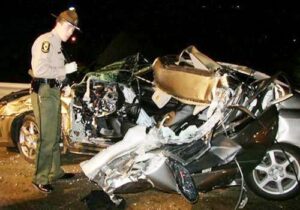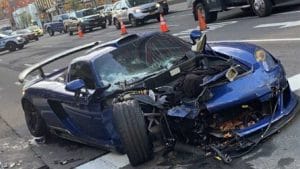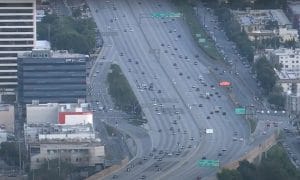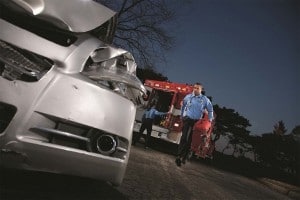
Despite driving 25.5% fewer miles in May, U.S. motorists saw the fatality rate per miles driven jump 23.5% for the period.
For the third consecutive month, U.S. motorists are driving less, but dying more often, according to early estimates from the National Safety Council.
The NSC revealed that with May’s data accounted for from all 50 states, despite the fact that most of the country was in some form of lockdown, the fatality rate per miles driven rose again. The organization revealed that the number of miles traveled by drivers fell 25.5% compared with May 2019.
However, the death rate was up 23.5% during the same period a year ago. The increased rate comes in spite of an estimated 8% drop in the number of deaths for May compared to the prior year. Overall, the mileage death rate per 100 million vehicle miles driven was 1.47 in May compared to 1.19 in 2019.
(High-speed crashes rise as drivers go faster due to lighter traffic due stay-at-home orders.)
“As motor vehicle crashes are the leading cause of workplace fatalities, transportation safety should be integral to every organization,” said Lorraine M. Martin, president and CEO of the National Safety Council.

The lighter traffic volumes due to shelter-in-place orders have given some drivers a little too much courage.
“An employer’s reopening strategy is an opportunity to emphasize and reiterate the need for safe streets, as well as safe workplace transportation. Employers can make a real difference in improving safety on our roadways, helping to protect their employees, as well as other road users.”
The trend is stunning given the lack of traffic on the roads, comparatively speaking. The U.S. had seen steady declines in fatalities in recent years, after a three-year rise – 2015 to 2017 – in deaths. This came despite vehicles that are safer than ever.
The jump being tied to one thing: drivers are willing to engage in riskier behavior due to the lighter traffic volumes.
“… while claims and miles driven are decreasing, one thing has increased – drivers’ appetite for risk. During COVID-19, risk homeostasis is in full force,” the Certified Collateral Corp. (CCC) revealed in a recent report about driving behaviors.
“People often maintain an equilibrium of risk. When perceived risk decreases or increases, behavior adjusts in the counter direction to maintain an equilibrium rather than accepting the new level of risk. In the case of COVID-19, rather than experiencing the safety benefits of an open road,
drivers increased speed, were more distracted and braked harder,” the report noted.
(Despite lockdowns, Americans still count on their cars to cope with pandemic.)
Speeding during COVID-19 increased 27%, including in metro areas. For example, the average interstate speed in Los Angeles more than doubled from 19 mph to 68 mph on I-405. Meanwhile I-290 in Chicago, the average speed jumped from 24 mph to 62 mph.
Risky and distracted driving has also increased. According to ZenDrive, hard braking is up 25% and phone usage is up 38% among drivers. This equates to a 20% increase in crash frequency per mile driven during COVID-19, despite an overall decline in the number of crashes.
With many vehicles now traveling at faster speeds, those that are getting in accidents are seeing greater damage, to both the vehicle and its occupants. This all happening at a time when, the NSC believes the country should be reaping a safety benefit from less traffic.
Through the first five months of 2020, the six states experienced notable increases in the number of roadway deaths: New Hampshire (63%), Connecticut (39%), Louisiana (15%), Missouri (12%), Arkansas (10%) and North Carolina (6%).
Additionally, nine states with notable decreases were: Tennessee (-58%), Wyoming (-52%), Mississippi (-21%), Maryland (-18%), Michigan (-13%), South Carolina (-13%), Pennsylvania (-13%), Arizona (-10%) and Florida (-4%).
(Empty roads mean faster speeds.)
Follow state and local directives and stay off the roads if officials have directed you do to so. During shelter-in-place and stay-at-home periods, many states asked drivers to stay off the roads except in emergency situations or for essential errands.



Just curious if the drivers are tested for drugs other than alcohol. This is the first year with marijuana legalization in a few states. Not suggesting it’s the cause but drivers should be checked for all drugs to study any new correlations.
Covid19 can also be a stress/anxiety/depression inducer in many. The high speed driving may not just be because of the less congested roads. Could be a direct psychological reaction to the pandemic or a reaction to drugs taken to alleviate negative psychological effects of Covid19.
As with alcohol, testing is uneven. The bigger concern is that no one has a test that can show if the driver was “under the influence” of THC. The peculiar issue is that it remains in the blood long after it no longer has any psychotropic effect.
Paul E.
It’s mostly young men that speed by me. Smokers of weed don’t drive fast. Slow? Yes.
Due to reduced volume, all the miles people traveled in gridlock traffic, where nobody dies, are now miles traveled in free-flow traffic, where fatalities can occur. There is no problem, this is just more fear-mongering propaganda in support of bad policy that maximizes ticketing. Get a clue.
Nope…when you see numbers like this, there’s a problem. I personally drive at, er, “extra-legal” speeds. I have been seeing numbers that stun me. Worse, as my friend and local police chief pointed out, “it’s not speeding that I’m worried about. It’s the other bad behavior.” A great example from a 40-mile drive I took the other day: traffic is averaging over 80 in a 70 zone, about 85 in the hammer lane. A kid in a tricked out Ford comes up at an easy 100. Before I can slide to the center lane to let him by he yanks the wheel, shoots over to the right and nearly onto the shoulder, then weaves between four lanes to get out front, cutting off two already fast moving cars within inches of their bumpers. That wasn’t a rare sighting. I see this all the time. It’s speed and recklessness. The good news is that many of the cops I have talked to are actually upping the speeds they pull over a driver for, many now at 15, even 20 over. But they are cracking down on the crazies. I hope that approach continues.
Paul E.